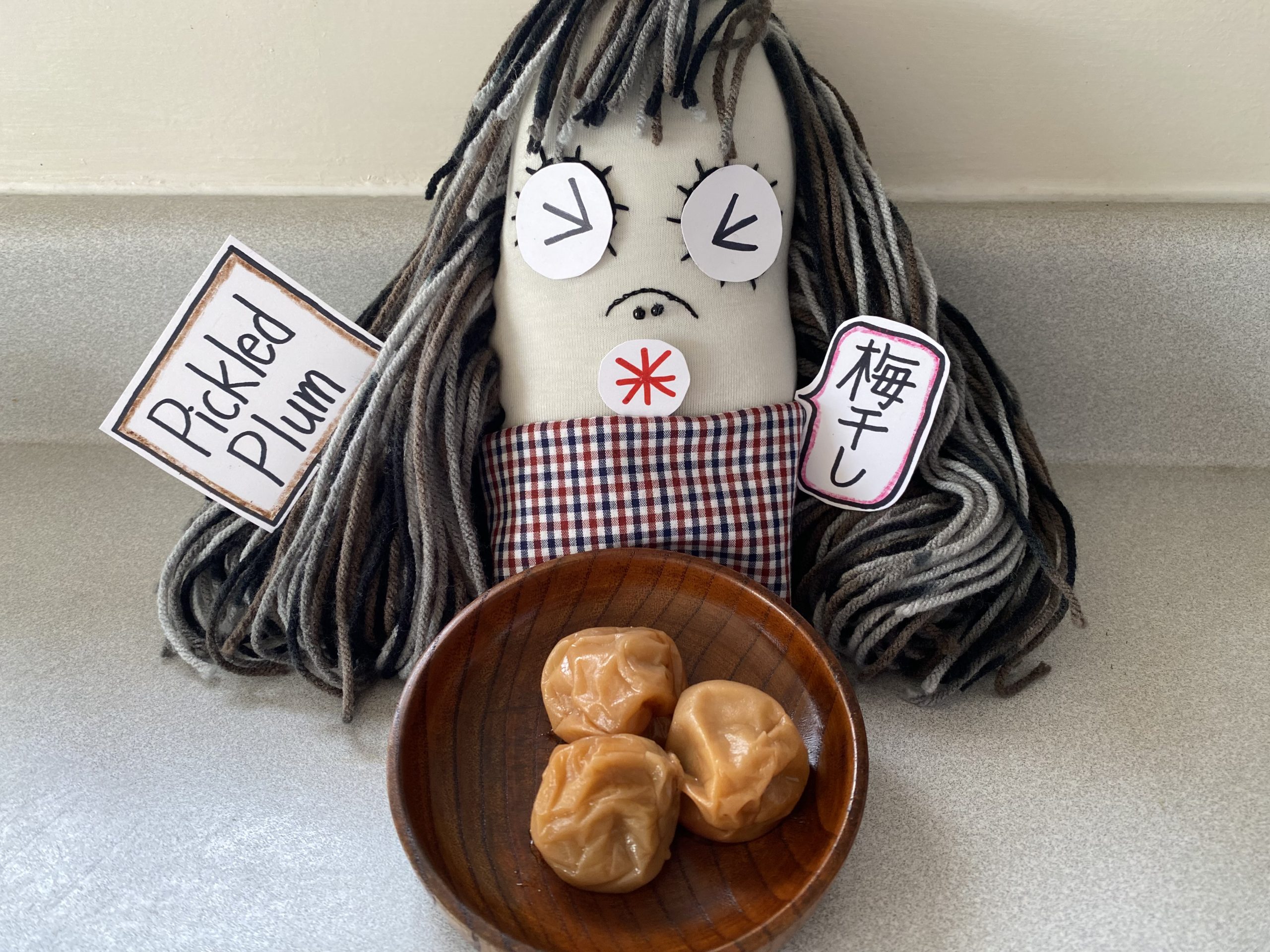
How good are umeboshi for our long-term stockpile?
“What is umeboshi??”
“I have never seen umeboshi…”
“What is that!!!”
“Ummm… No thank you… It looks strange…”
Please picture, in your mind, the Japanese flag. Can you see the big, red dot right in the middle? Believe it or not, that is umeboshi!
OK, I am kidding, but Japanese people sometimes make lunch boxes that look like a Japanese flag. We call it a hinomaru bento. 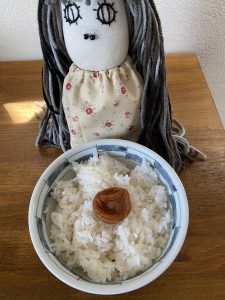 Hinomaru means circle of the sun, and bento is lunch box. We just put white rice and a single umeboshi (pickled plum) in the middle. This style lunch box may look simple and cheap, but actually it’s very healthy and tasty. Most people don’t know just how good it is. Umeboshi is the star of hinomaru bento, and I strongly recommend you get umeboshi for your long-term stockpile.
Hinomaru means circle of the sun, and bento is lunch box. We just put white rice and a single umeboshi (pickled plum) in the middle. This style lunch box may look simple and cheap, but actually it’s very healthy and tasty. Most people don’t know just how good it is. Umeboshi is the star of hinomaru bento, and I strongly recommend you get umeboshi for your long-term stockpile.
What are umeboshi?
Red, round and wrinkled, with a distinctly sour taste, umeboshi are the fruit of the ume tree — a relative of the apricot and the plum — that have been fermented, salted, and dried, in batches, in the summer sun. Ume (梅) means “plum” and boshi (干す) is a form of the verb “to dry”. During the process of fermentation, sea salt gives the plum its brine, and the addition of red shiso leaves creates a pink hue. The Umeboshi are left to dry and age for months or even years before they are enjoyed.
Ume has three times more citric acid than a regular lemon. This gives umeboshi their astringent flavor, but the sour shock is made more pronounced by the salt used to cure the fruit. While salt content is variable, the traditional recipe calls for picking with salt that has at least 20 percent sodium. If the count dips below that mark, the fruit can mold. You can keep umeboshi for years without them going bad if they are made with traditional methods. The oldest umeboshi found in Japan are estimated to have been pickled in 1576 and are still edible today.
Long-lasting umeboshi are made using traditional methods, have a salt content of over 20%, and do not contain any preservatives or artificial colors. They do not go bad, even if unrefrigerated and kept at room temperature; the salt content over 20% makes this possible. Umeboshi sold at supermarkets often contain seasoning and preservatives (such as honey), and there are also low sodium umeboshi. Depending on the variety, some of these umeboshi are only 5-10% salt. Many of these supermarket umeboshi will go bad unless kept in a refrigerator.
What are the health benefits of umeboshi?
There are lots of proverbs related to umeboshi and their health benefits. For example…
- Umeboshi will neutralize three poisons (梅は三毒を断つ): The three types of poison are food, blood and water.
- An umeboshi a day keeps the doctor away (梅干し一個で医者いらず): Like “An apple a day keeps the doctor away.”
- One Umeboshi prevents misfortune (梅はその日の難逃れ): Eating umeboshi every morning will help a person avoid difficulties that day.
- Have a strong alkalizing effect on blood.
- Reduce fatigue.
- Improve circulation.
- Stimulate appetite.
- Have strong antiseptic properties and help defend against food poisoning. (That’s why we put the umeboshi in the middle of the hinomaru bento, to maximize the protective effects.)
- Help absorption of calcium and iron.
- Promote good digestion.
- Improve liver function & help with hangovers
- Boost the immune system.
- Prevent cavities and oral disease.
Umeboshi are high in citric acid and contain essential vitamins such as vitamins A, C, B, E and K, as well as minerals like iron, copper and zinc. Also, umeboshi have fiber, antioxidants, and polyphenols.
How to store
You can store umeboshi permanently if they are pickled with 20% or more salt. Avoid storing them in a hot or humid place. Direct sunlight causes damage to umeboshi. Storage in a glass or ceramic jar is recommended. When umeboshi are pickled with less than 20% salt or contain additional seasoning or preservatives, consume them within one year, and once they are unsealed, store them in the fridge.
I picked up…
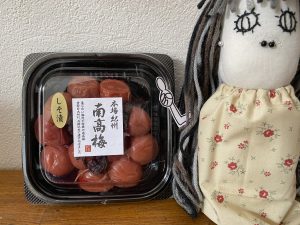 Umeboshi are produced in many areas, but the Kishu-ume, produced in Wakayama prefecture, is the most famous. So I tried to get Kishu-ume which is over 20% salt and sun-dried. The real traditional umeboshi are naturally sun-dried. Much of the umeboshi you can buy at the store are, sadly, soaked in a chemical solution. I check the umeboshi packaging carefully and buy the ones without any chemicals.
Umeboshi are produced in many areas, but the Kishu-ume, produced in Wakayama prefecture, is the most famous. So I tried to get Kishu-ume which is over 20% salt and sun-dried. The real traditional umeboshi are naturally sun-dried. Much of the umeboshi you can buy at the store are, sadly, soaked in a chemical solution. I check the umeboshi packaging carefully and buy the ones without any chemicals.
How to eat it in an emergency situation
Just eat the umeboshi, if you can. But if it’s too sour for you, you can eat umeboshi with something. For example:
Crushed umeboshi tea
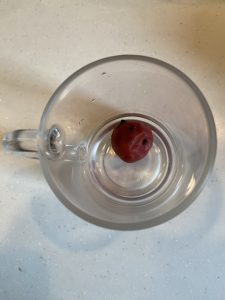
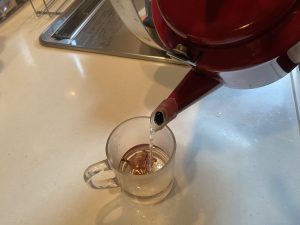
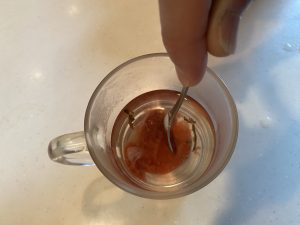
Pour hot water or green tea over your umeboshi, and then crush it with a spoon. Then drink it. It’s delicious! I usually drink this when I feel cold, hungover, or if I’m worried about heatstroke.
Umeboshi riceball
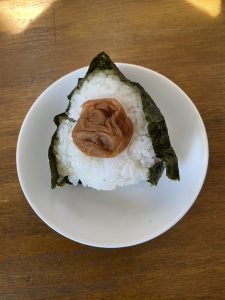
Sorry, my rice ball is not well shaped… but it’s my easy way to eat umeboshi.
After you eat an umeboshi, keep the seed, and you will be able to plant an ume tree. And then you can make your own umeboshi. When you visit Japan, you can see many Japanese people trying to make their own umeboshi, in the summertime. My grandmother used to make her own umeboshi, every summer, and I can still remember the smell of drying umeboshi, when I think back. Umeboshi is, in a way, the soul of Japan, and that’s why umeboshi is in the middle of our flag.
I strongly recommend umeboshi. If you have never eaten one, please try it.
See you next time.